The Cambridge History of Japan, Vol. 4: Early Modern Japan
Подождите немного. Документ загружается.

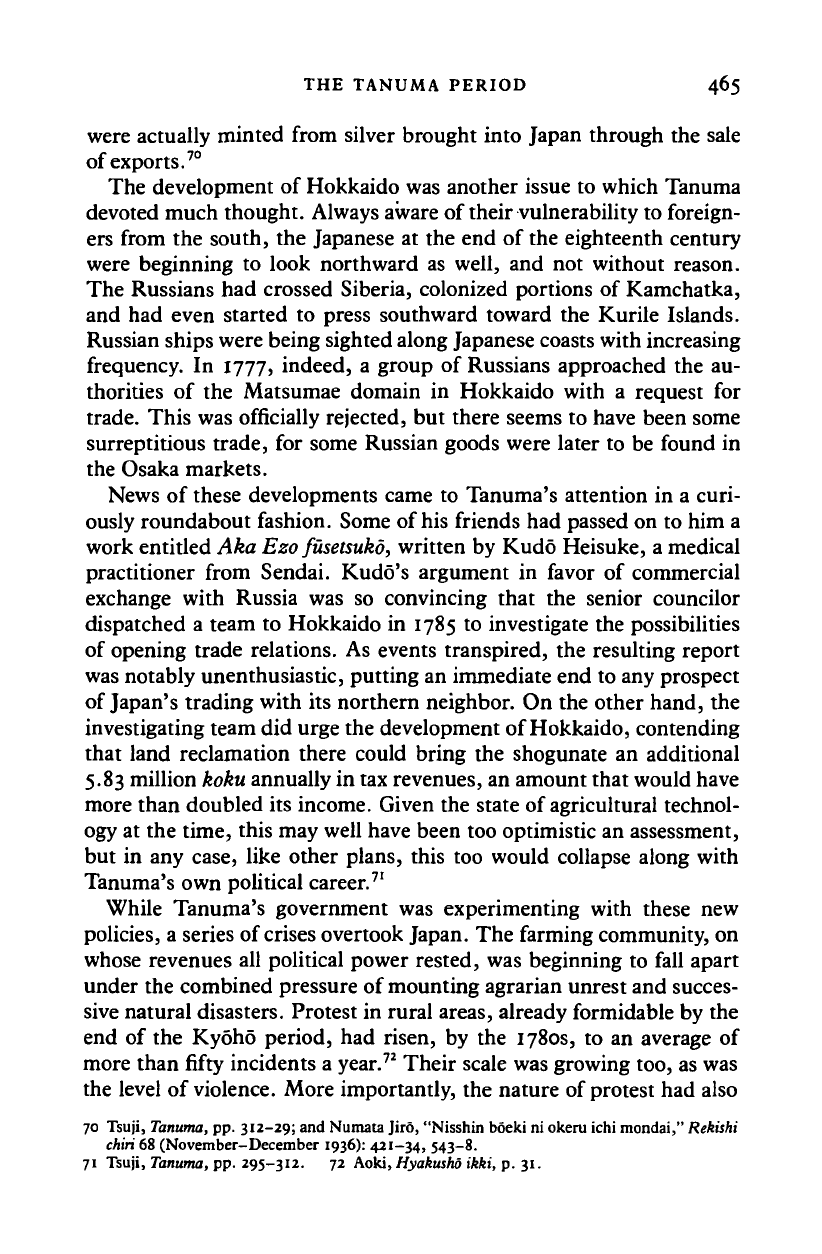
THE TANUMA PERIOD 465
were actually minted from silver brought into Japan through the sale
of exports.
70
The development of Hokkaido was another issue to which Tanuma
devoted much thought. Always aware of their vulnerability to foreign-
ers from the south, the Japanese at the end of the eighteenth century
were beginning to look northward as well, and not without reason.
The Russians had crossed Siberia, colonized portions of Kamchatka,
and had even started to press southward toward the Kurile Islands.
Russian ships were being sighted along Japanese coasts with increasing
frequency. In 1777, indeed, a group of Russians approached the au-
thorities of the Matsumae domain in Hokkaido with a request for
trade. This was officially rejected, but there seems to have been some
surreptitious trade, for some Russian goods were later to be found in
the Osaka markets.
News of these developments came to Tanuma's attention in a curi-
ously roundabout fashion. Some of his friends had passed on to him a
work entitled Aka Ezo
fusetsuko,
written by Kudo Heisuke, a medical
practitioner from Sendai. Kudo's argument in favor of commercial
exchange with Russia was so convincing that the senior councilor
dispatched a team to Hokkaido in 1785 to investigate the possibilities
of opening trade relations. As events transpired, the resulting report
was notably unenthusiastic, putting an immediate end to any prospect
of Japan's trading with its northern neighbor. On the other hand, the
investigating team did urge the development of Hokkaido, contending
that land reclamation there could bring the shogunate an additional
5.83 million koku annually in tax revenues, an amount that would have
more than doubled its income. Given the state of agricultural technol-
ogy at the time, this may well have been too optimistic an assessment,
but in any case, like other plans, this too would collapse along with
Tanuma's own political career.
71
While Tanuma's government was experimenting with these new
policies, a series of
crises
overtook Japan. The farming community, on
whose revenues all political power rested, was beginning to fall apart
under the combined pressure of mounting agrarian unrest and succes-
sive natural disasters. Protest in rural areas, already formidable by the
end of the Kyoho period, had risen, by the 1780s, to an average of
more than fifty incidents a year.
72
Their scale was growing too, as was
the level of
violence.
More importantly, the nature of protest had also
70 Tsuji, Tanuma, pp. 312-29; and Numata Jiro, "Nisshin boeki ni okeru ichi mondai," Rekishi
chiri
68 (November-December 1936): 421-34, 543-8.
71 Tsuji, Tanuma, pp. 295-312. 72 Aoki, Hyakusho ikki, p. 31.
Cambridge Histories Online © Cambridge University Press, 2008
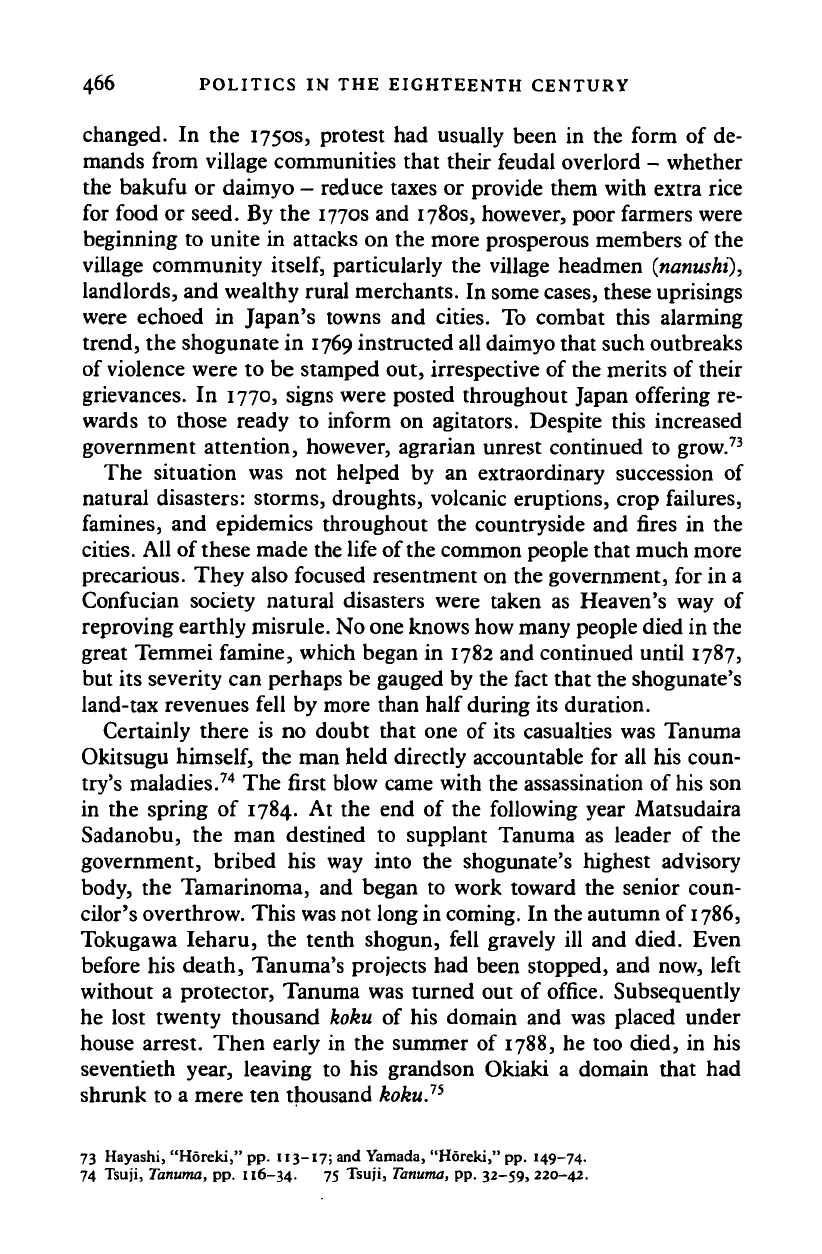
466 POLITICS IN THE EIGHTEENTH CENTURY
changed. In the 1750s, protest had usually been in the form of de-
mands from village communities that their feudal overlord - whether
the bakufu or daimyo - reduce taxes or provide them with extra rice
for food or seed. By the 1770s and 1780s, however, poor farmers were
beginning to unite in attacks on the more prosperous members of the
village community
itself,
particularly the village headmen (nanushi),
landlords, and wealthy rural merchants. In some cases, these uprisings
were echoed in Japan's towns and cities. To combat this alarming
trend, the shogunate in 1769 instructed all daimyo that such outbreaks
of violence were to be stamped out, irrespective of the merits of their
grievances. In 1770, signs were posted throughout Japan offering re-
wards to those ready to inform on agitators. Despite this increased
government attention, however, agrarian unrest continued to grow.
73
The situation was not helped by an extraordinary succession of
natural disasters: storms, droughts, volcanic eruptions, crop failures,
famines, and epidemics throughout the countryside and fires in the
cities.
All of these made the life of the common people that much more
precarious. They also focused resentment on the government, for in a
Confucian society natural disasters were taken as Heaven's way of
reproving earthly misrule. No one knows how many people died in the
great Temmei famine, which began in 1782 and continued until 1787,
but its severity can perhaps be gauged by the fact that the shogunate's
land-tax revenues fell by more than half during its duration.
Certainly there is no doubt that one of its casualties was Tanuma
Okitsugu
himself,
the man held directly accountable for all his coun-
try's maladies.
74
The first blow came with the assassination of his son
in the spring of 1784. At the end of the following year Matsudaira
Sadanobu, the man destined to supplant Tanuma as leader of the
government, bribed his way into the shogunate's highest advisory
body, the Tamarinoma, and began to work toward the senior coun-
cilor's overthrow. This was not long in
coming.
In the autumn of 1786,
Tokugawa Ieharu, the tenth shogun, fell gravely ill and died. Even
before his death, Tanuma's projects had been stopped, and now, left
without a protector, Tanuma was turned out of office. Subsequently
he lost twenty thousand koku of his domain and was placed under
house arrest. Then early in the summer of 1788, he too died, in his
seventieth year, leaving to his grandson Okiaki a domain that had
shrunk to a mere ten thousand koku.
ls
73 Hayashi, "Horeki," pp. 113-17; and Yamada, "Horeki," pp. 149-74.
74 Tsuji, Tanuma, pp. 116-34. 75 Tsuji, Tanuma, pp. 32-59, 220-42.
Cambridge Histories Online © Cambridge University Press, 2008
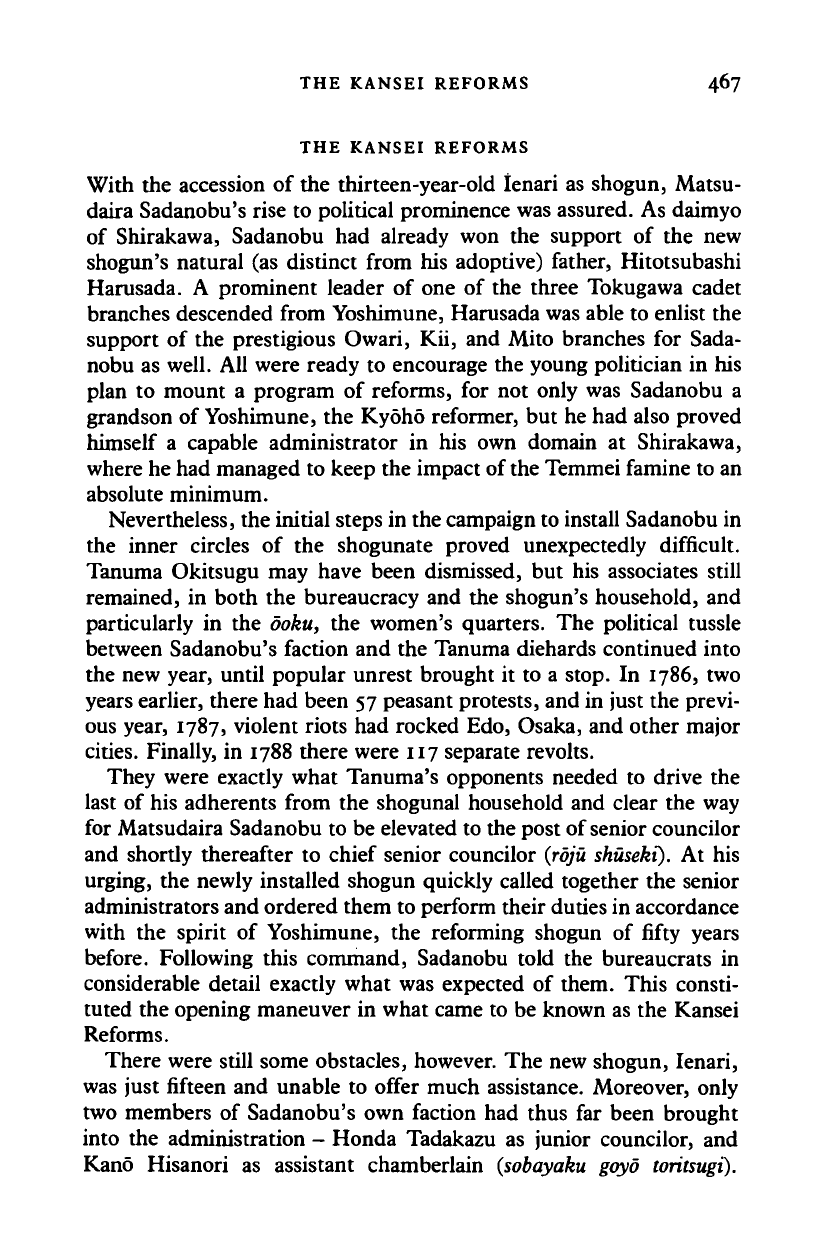
THE KANSEI REFORMS 467
THE KANSEI REFORMS
With the accession of the thirteen-year-old ienari as shogun, Matsu-
daira Sadanobu's rise to political prominence was assured. As daimyo
of Shirakawa, Sadanobu had already won the support of the new
shogun's natural (as distinct from his adoptive) father, Hitotsubashi
Harusada. A prominent leader of one of the three Tokugawa cadet
branches descended from Yoshimune, Harusada was able to enlist the
support of the prestigious Owari, Kii, and Mito branches for Sada-
nobu as well. All were ready to encourage the young politician in his
plan to mount a program of reforms, for not only was Sadanobu a
grandson of Yoshimune, the Kyoho reformer, but he had also proved
himself a capable administrator in his own domain at Shirakawa,
where he had managed to keep the impact of
the
Temmei famine to an
absolute minimum.
Nevertheless, the initial steps in the campaign to install Sadanobu in
the inner circles of the shogunate proved unexpectedly difficult.
Tanuma Okitsugu may have been dismissed, but his associates still
remained, in both the bureaucracy and the shogun's household, and
particularly in the ooku, the women's quarters. The political tussle
between Sadanobu's faction and the Tanuma diehards continued into
the new year, until popular unrest brought it to a stop. In 1786, two
years earlier, there had been 57 peasant protests, and in just the previ-
ous year, 1787, violent riots had rocked Edo, Osaka, and other major
cities.
Finally, in 1788 there were 117 separate revolts.
They were exactly what Tanuma's opponents needed to drive the
last of his adherents from the shogunal household and clear the way
for Matsudaira Sadanobu to be elevated to the post of senior councilor
and shortly thereafter to chief senior councilor
(roju
shuseki).
At his
urging, the newly installed shogun quickly called together the senior
administrators and ordered them to perform their duties in accordance
with the spirit of Yoshimune, the reforming shogun of fifty years
before. Following this command, Sadanobu told the bureaucrats in
considerable detail exactly what was expected of them. This consti-
tuted the opening maneuver in what came to be known as the Kansei
Reforms.
There were still some obstacles, however. The new shogun, Ienari,
was just fifteen and unable to offer much assistance. Moreover, only
two members of Sadanobu's own faction had thus far been brought
into the administration - Honda Tadakazu as junior councilor, and
Kano Hisanori as assistant chamberlain (sobayaku gqyo toritsugi).
Cambridge Histories Online © Cambridge University Press, 2008
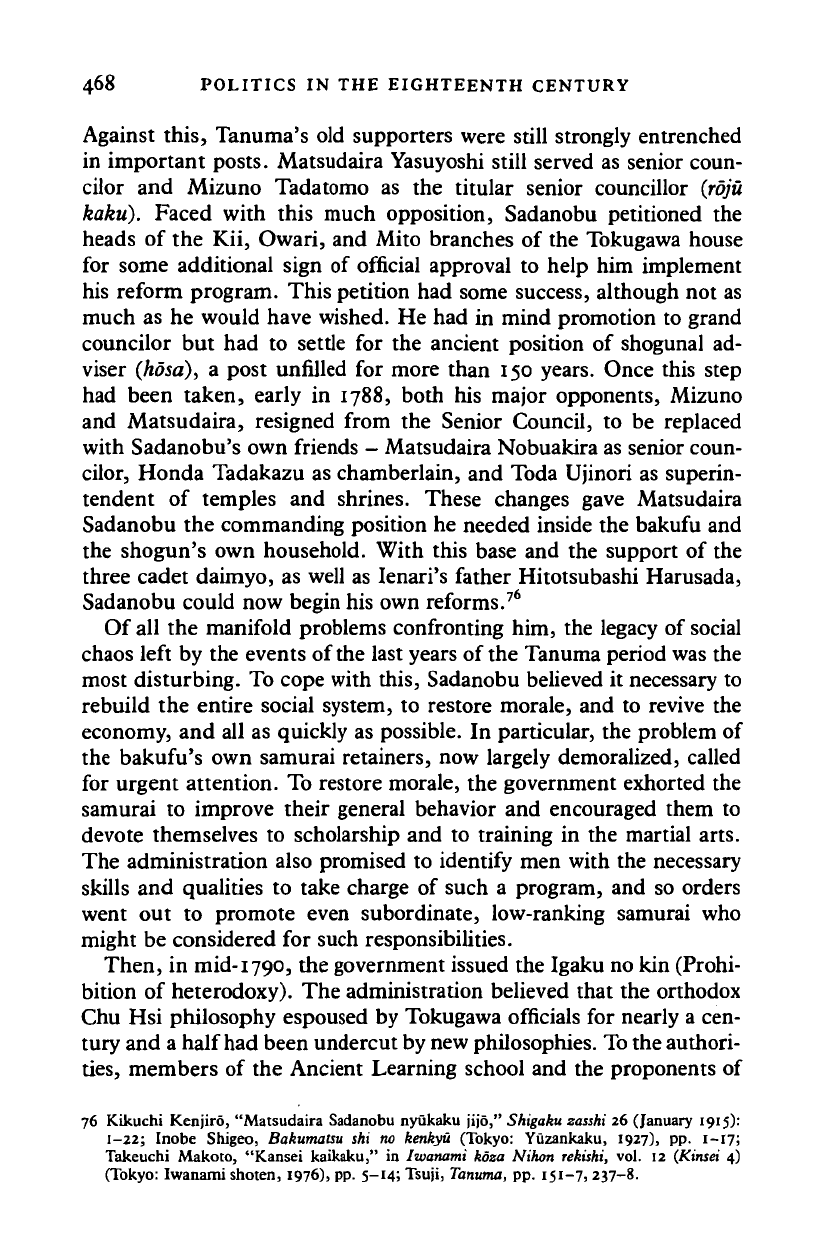
468 POLITICS IN THE EIGHTEENTH CENTURY
Against this, Tanuma's old supporters were still strongly entrenched
in important posts. Matsudaira Yasuyoshi still served as senior coun-
cilor and Mizuno Tadatomo as the titular senior councillor (roju
kaku).
Faced with this much opposition, Sadanobu petitioned the
heads of the Kii, Owari, and Mito branches of the Tokugawa house
for some additional sign of official approval to help him implement
his reform program. This petition had some success, although not as
much as he would have wished. He had in mind promotion to grand
councilor but had to settle for the ancient position of shogunal ad-
viser (hosa), a post unfilled for more than 150 years. Once this step
had been taken, early in 1788, both his major opponents, Mizuno
and Matsudaira, resigned from the Senior Council, to be replaced
with Sadanobu's own friends - Matsudaira Nobuakira as senior coun-
cilor, Honda Tadakazu as chamberlain, and Toda Ujinori as superin-
tendent of temples and shrines. These changes gave Matsudaira
Sadanobu the commanding position he needed inside the bakufu and
the shogun's own household. With this base and the support of the
three cadet daimyo, as well as Ienari's father Hitotsubashi Harusada,
Sadanobu could now begin his own reforms.
76
Of all the manifold problems confronting him, the legacy of social
chaos left by the events of the last years of the Tanuma period was the
most disturbing. To cope with this, Sadanobu believed it necessary to
rebuild the entire social system, to restore morale, and to revive the
economy, and all as quickly as possible. In particular, the problem of
the bakufu's own samurai retainers, now largely demoralized, called
for urgent attention. To restore morale, the government exhorted the
samurai to improve their general behavior and encouraged them to
devote themselves to scholarship and to training in the martial arts.
The administration also promised to identify men with the necessary
skills and qualities to take charge of such a program, and so orders
went out to promote even subordinate, low-ranking samurai who
might be considered for such responsibilities.
Then, in mid-1790, the government issued the Igaku no kin (Prohi-
bition of heterodoxy). The administration believed that the orthodox
Chu Hsi philosophy espoused by Tokugawa officials for nearly a cen-
tury and
a
half had been undercut by new philosophies.
To
the authori-
ties,
members of the Ancient Learning school and the proponents of
76 Kikuchi Kenjiro, "Matsudaira Sadanobu nyukaku jijo," Shigaku zasshi 26 (January 1915):
1-22; Inobe Shigeo, Bakumatsu shi no kenkyu (Tokyo: Yuzankaku, 1927), pp. 1-17;
Takeuchi Makoco, "Kansei kaikaku," in Iwanami koza Nihon rekishi, vol. 12 (Kinsei 4)
(Tokyo: Iwanami shoten, 1976), pp. 5-14; Tsuji, Tanuma, pp. 151-7, 237-8.
Cambridge Histories Online © Cambridge University Press, 2008
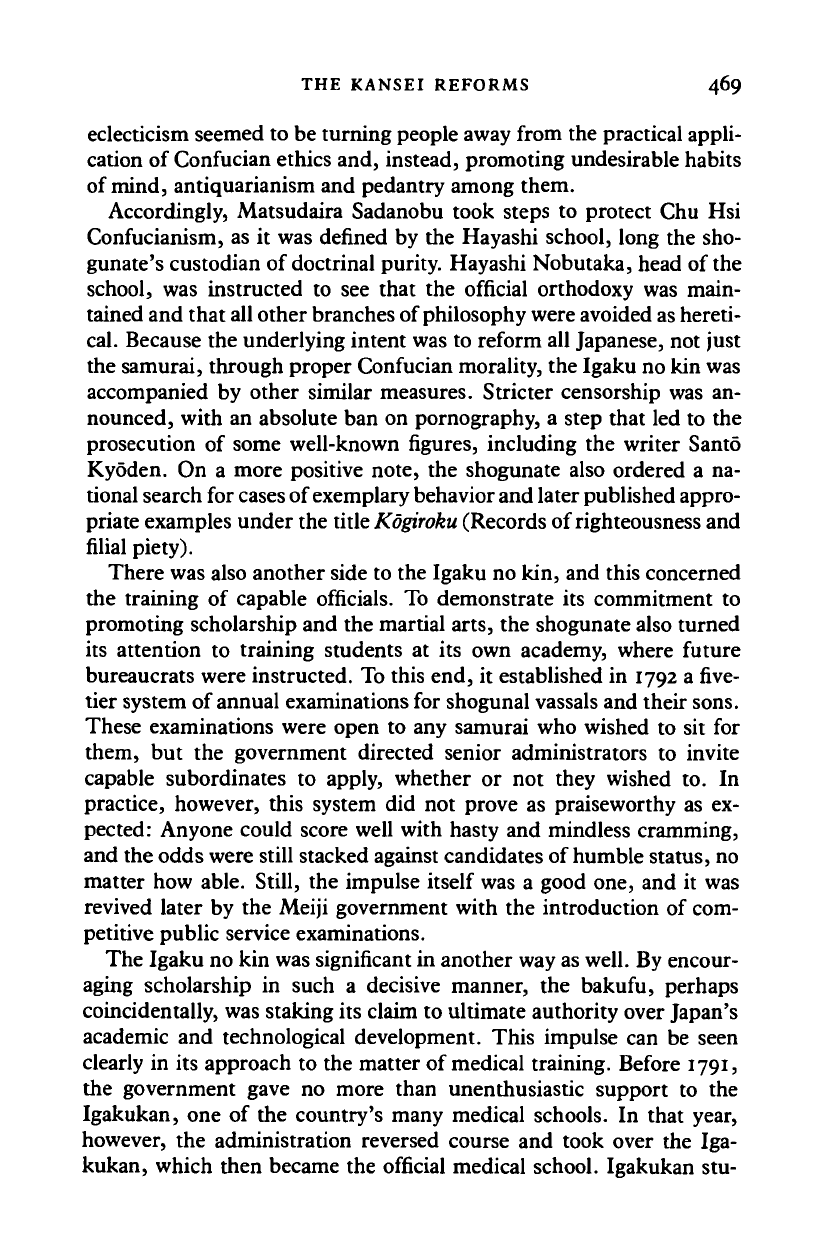
THE KANSEI REFORMS 469
eclecticism seemed to be turning people away from the practical appli-
cation of Confucian ethics and, instead, promoting undesirable habits
of mind, antiquarianism and pedantry among them.
Accordingly, Matsudaira Sadanobu took steps to protect Chu Hsi
Confucianism, as it was defined by the Hayashi school, long the sho-
gunate's custodian of doctrinal purity. Hayashi Nobutaka, head of the
school, was instructed to see that the official orthodoxy was main-
tained and that all other branches of philosophy were avoided as hereti-
cal.
Because the underlying intent was to reform all Japanese, not just
the samurai, through proper Confucian morality, the Igaku no kin was
accompanied by other similar measures. Stricter censorship was an-
nounced, with an absolute ban on pornography, a step that led to the
prosecution of some well-known figures, including the writer Santo
Kyoden. On a more positive note, the shogunate also ordered a na-
tional search for
cases
of exemplary behavior and later published appro-
priate examples under the title
Kogiroku
(Records of righteousness and
filial
piety).
There was also another side to the Igaku no kin, and this concerned
the training of capable officials. To demonstrate its commitment to
promoting scholarship and the martial arts, the shogunate also turned
its attention to training students at its own academy, where future
bureaucrats were instructed. To this end, it established in 1792 a five-
tier system of annual examinations for shogunal vassals and their sons.
These examinations were open to any samurai who wished to sit for
them, but the government directed senior administrators to invite
capable subordinates to apply, whether or not they wished to. In
practice, however, this system did not prove as praiseworthy as ex-
pected: Anyone could score well with hasty and mindless cramming,
and the odds were still stacked against candidates of humble status, no
matter how able. Still, the impulse itself was a good one, and it was
revived later by the Meiji government with the introduction of com-
petitive public service examinations.
The Igaku no kin was significant in another way as well. By encour-
aging scholarship in such a decisive manner, the bakufu, perhaps
coincidentally, was staking its claim to ultimate authority over Japan's
academic and technological development. This impulse can be seen
clearly in its approach to the matter of medical training. Before 1791,
the government gave no more than unenthusiastic support to the
Igakukan, one of the country's many medical schools. In that year,
however, the administration reversed course and took over the Iga-
kukan, which then became the official medical school. Igakukan stu-
Cambridge Histories Online © Cambridge University Press, 2008
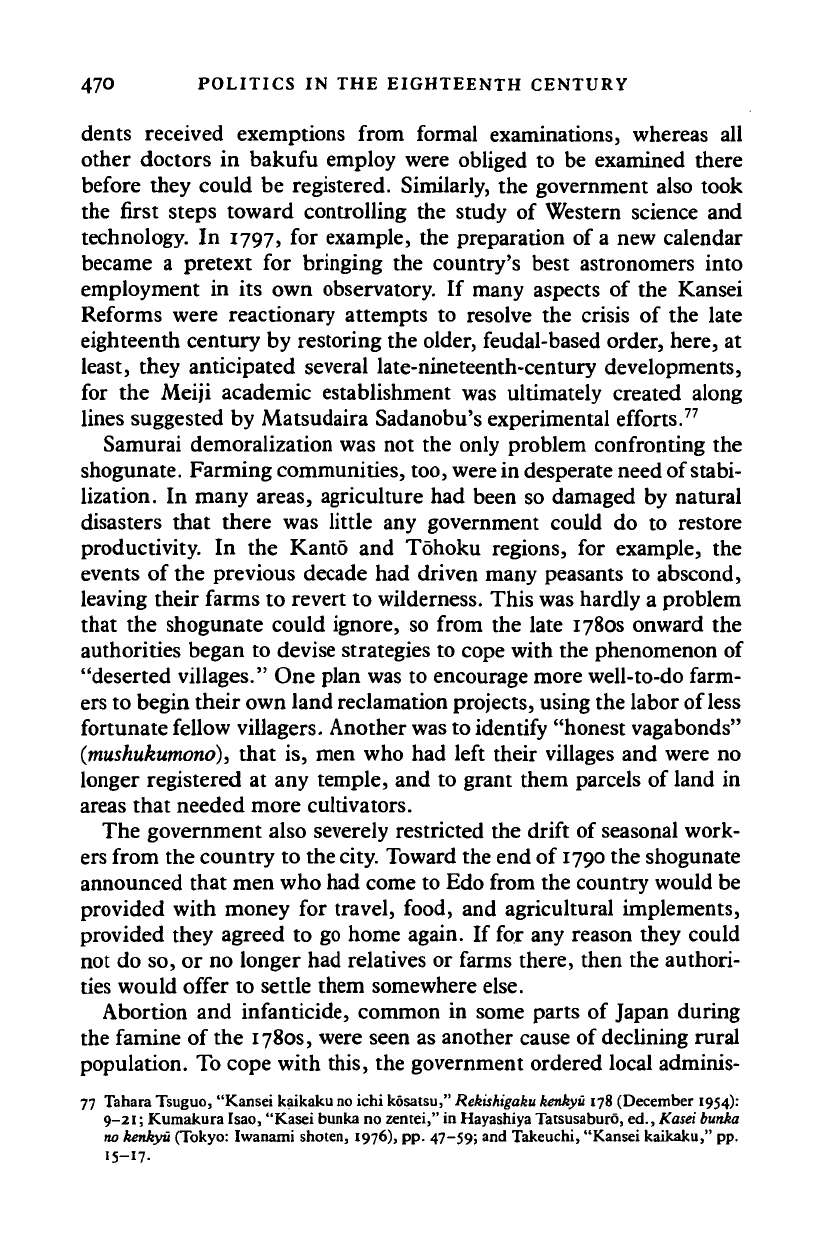
470 POLITICS IN THE EIGHTEENTH CENTURY
dents received exemptions from formal examinations, whereas all
other doctors in bakufu employ were obliged to be examined there
before they could be registered. Similarly, the government also took
the first steps toward controlling the study of Western science and
technology. In 1797, for example, the preparation of a new calendar
became a pretext for bringing the country's best astronomers into
employment in its own observatory. If many aspects of the Kansei
Reforms were reactionary attempts to resolve the crisis of the late
eighteenth century by restoring the older, feudal-based order, here, at
least, they anticipated several late-nineteenth-century developments,
for the Meiji academic establishment was ultimately created along
lines suggested by Matsudaira Sadanobu's experimental efforts.
77
Samurai demoralization was not the only problem confronting the
shogunate. Farming communities, too, were in desperate need of stabi-
lization. In many areas, agriculture had been so damaged by natural
disasters that there was little any government could do to restore
productivity. In the Kanto and Tohoku regions, for example, the
events of the previous decade had driven many peasants to abscond,
leaving their farms to revert to wilderness. This was hardly a problem
that the shogunate could ignore, so from the late 1780s onward the
authorities began to devise strategies to cope with the phenomenon of
"deserted villages." One plan was to encourage more well-to-do farm-
ers to begin their own land reclamation projects, using the labor of less
fortunate fellow villagers. Another was to identify "honest vagabonds"
(mushukumono),
that is, men who had left their villages and were no
longer registered at any temple, and to grant them parcels of land in
areas that needed more cultivators.
The government also severely restricted the drift of seasonal work-
ers from the country to the
city.
Toward the end of 1790 the shogunate
announced that men who had come to Edo from the country would be
provided with money for travel, food, and agricultural implements,
provided they agreed to go home again. If for any reason they could
not do so, or no longer had relatives or farms there, then the authori-
ties would offer to settle them somewhere else.
Abortion and infanticide, common in some parts of Japan during
the famine of the 1780s, were seen as another cause of declining rural
population. To cope with this, the government ordered local adminis-
77 Tahara Tsuguo, "Kansei kaikaku
no
ichi kosatsu,"
Rekishigaku kenkyu
178 (December 1954):
9—21;
Kumakura Isao, "Kasei bunka no zencei," in Hayashiya Tatsusaburo, ed.,
Kasei bunka
no kenkyu
(Tokyo:
Iwanami shoten, 1976), pp. 47-59; and Takeuchi, "Kansei kaikaku," pp.
15-17.
Cambridge Histories Online © Cambridge University Press, 2008
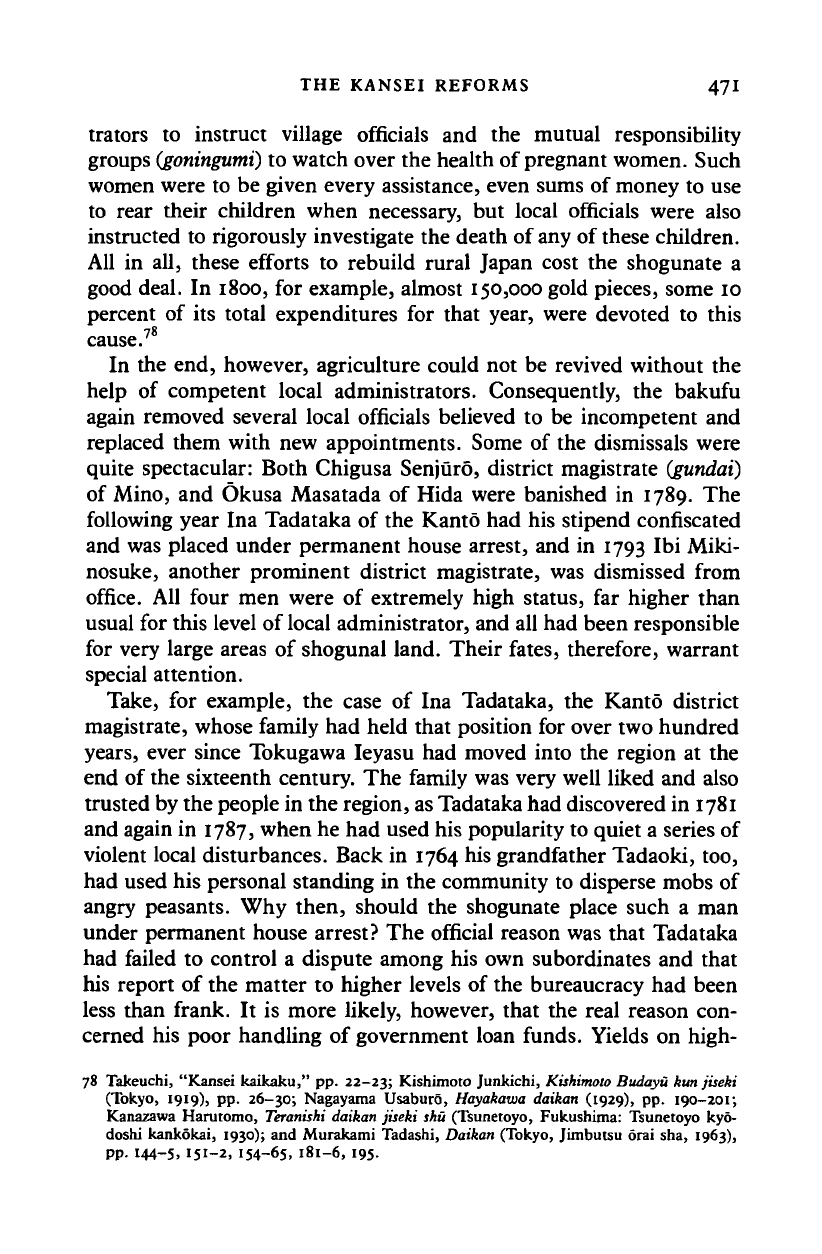
THE KANSEI REFORMS 471
trators to instruct village officials and the mutual responsibility
groups
(goningumi)
to watch over the health of pregnant women. Such
women were to be given every assistance, even sums of money to use
to rear their children when necessary, but local officials were also
instructed to rigorously investigate the death of any of these children.
All in all, these efforts to rebuild rural Japan cost the shogunate a
good deal. In 1800, for example, almost 150,000 gold pieces, some 10
percent of its total expenditures for that year, were devoted to this
cause.
78
In the end, however, agriculture could not be revived without the
help of competent local administrators. Consequently, the bakufu
again removed several local officials believed to be incompetent and
replaced them with new appointments. Some of the dismissals were
quite spectacular: Both Chigusa Senjuro, district magistrate
(gundai)
of Mino, and Okusa Masatada of Hida were banished in 1789. The
following year Ina Tadataka of the Kanto had his stipend confiscated
and was placed under permanent house arrest, and in 1793 Ibi Miki-
nosuke, another prominent district magistrate, was dismissed from
office. All four men were of extremely high status, far higher than
usual for this level of
local
administrator, and all had been responsible
for very large areas of shogunal land. Their fates, therefore, warrant
special attention.
Take, for example, the case of Ina Tadataka, the Kanto district
magistrate, whose family had held that position for over two hundred
years,
ever since Tokugawa Ieyasu had moved into the region at the
end of the sixteenth century. The family was very well liked and also
trusted by the people in the region, as Tadataka had discovered in 1781
and again in 1787, when he had used his popularity to quiet a series of
violent local disturbances. Back in 1764 his grandfather Tadaoki, too,
had used his personal standing in the community to disperse mobs of
angry peasants. Why then, should the shogunate place such a man
under permanent house arrest? The official reason was that Tadataka
had failed to control a dispute among his own subordinates and that
his report of the matter to higher levels of the bureaucracy had been
less than frank. It is more likely, however, that the real reason con-
cerned his poor handling of government loan funds. Yields on high-
78 Takeuchi, "Kansei kaikaku," pp. 22-23; Kishimoto Junkichi, Kishimoto Budayu
kun
jiseki
(Tokyo, 1919), pp. 26-30; Nagayama Usaburo, Hayakawa daikan (1929), pp. 190-201;
Kanazawa Harutomo, Teranishi daikan jiseki shu (Tsunetoyo, Fukushima: Tsunetoyo kyo-
doshi kankokai, 1930); and Murakami Tadashi, Daikan (Tokyo, Jimbutsu orai sha, 1963),
pp.
144-5, 151-2, 154-65. 181-6, 195.
Cambridge Histories Online © Cambridge University Press, 2008
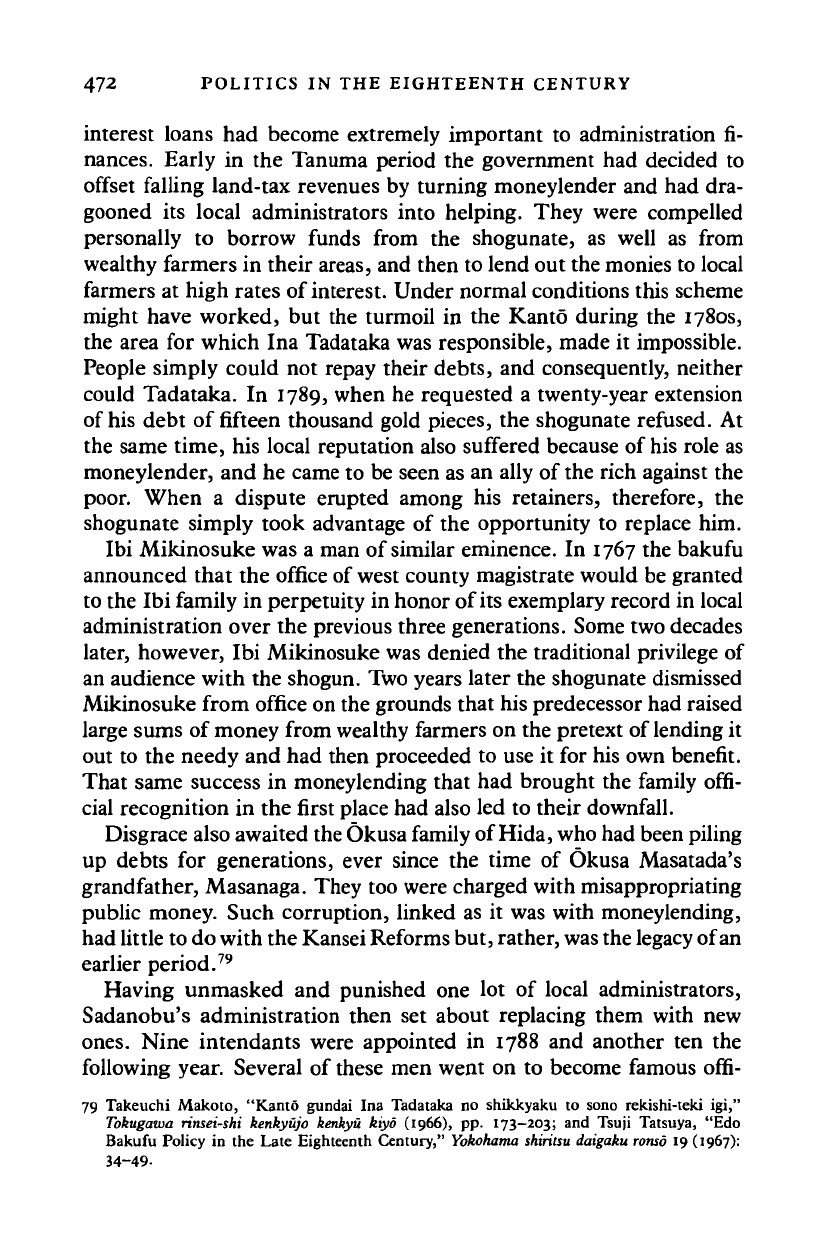
472 POLITICS IN THE EIGHTEENTH CENTURY
interest loans had become extremely important to administration fi-
nances. Early in the Tanuma period the government had decided to
offset falling land-tax revenues by turning moneylender and had dra-
gooned its local administrators into helping. They were compelled
personally to borrow funds from the shogunate, as well as from
wealthy farmers in their areas, and then to lend out the monies to local
farmers at high rates of
interest.
Under normal conditions this scheme
might have worked, but the turmoil in the Kanto during the 1780s,
the area for which Ina Tadataka was responsible, made it impossible.
People simply could not repay their debts, and consequently, neither
could Tadataka. In 1789, when he requested a twenty-year extension
of his debt of fifteen thousand gold pieces, the shogunate refused. At
the same time, his local reputation also suffered because of his role as
moneylender, and he came to be seen as an ally of the rich against the
poor. When a dispute erupted among his retainers, therefore, the
shogunate simply took advantage of the opportunity to replace him.
Ibi Mikinosuke was a man of similar eminence. In 1767 the bakufu
announced that the office of west county magistrate would be granted
to the Ibi family in perpetuity in honor of its exemplary record in local
administration over the previous three generations. Some two decades
later, however, Ibi Mikinosuke was denied the traditional privilege of
an audience with the shogun. Two years later the shogunate dismissed
Mikinosuke from office on the grounds that his predecessor had raised
large sums of money from wealthy farmers on the pretext of lending it
out to the needy and had then proceeded to use it for his own benefit.
That same success in moneylending that had brought the family offi-
cial recognition in the first place had also led to their downfall.
Disgrace also awaited the Okusa family of Hida, who had been piling
up debts for generations, ever since the time of Okusa Masatada's
grandfather, Masanaga. They too were charged with misappropriating
public money. Such corruption, linked as it was with moneylending,
had little to do with the Kansei Reforms but, rather,
was
the legacy of an
earlier period.
79
Having unmasked and punished one lot of local administrators,
Sadanobu's administration then set about replacing them with new
ones.
Nine intendants were appointed in 1788 and another ten the
following year. Several of these men went on to become famous offi-
79 Takeuchi Makoto, "Kanto gundai Ina Tadataka no shikkyaku to sono rekishi-teki igi,"
Tokugawa rinsei-shi kenkyujo kenkyu kiyo (1966), pp. 173-203; and Tsuji Tatsuya, "Edo
Bakufu Policy in the Late Eighteenth Century," Yokohama shiritsu daigaku
ronso
19 (1967):
34-49-
Cambridge Histories Online © Cambridge University Press, 2008

THE KANSEI REFORMS 473
cials.
Okada Hakaru (better known by his pen name of Kansen) was a
well-known Confucian scholar who, together with Shibano Ritsuzan,
had been active in the shogunate's academy. His appointment was a
gamble on Sadanobu's part, but it was a successful one. Some changes
were made further down the hierarchy as well. Instead of using local
peasants or commoners as clerks, a practice that had led to much
corruption in the past, the government now decided that its local
officials should appoint their subordinates from among the sho-
gunate's own vassals.
80
Despite all this activity, however, the bakufu never overcame cor-
ruption at the local level, especially the problems associated with
moneylending. Sadanobu's administration never considered a straight-
forward program of distributing grants of money for purposes like
land reclamation or the care of orphaned children. Instead, it en-
trusted large sums of money - as much as twenty thousand gold
pieces in some cases - to local officials with instructions that the
funds be lent out to wealthy peasants and merchants, and the interest
used to create a fund from which the poor could then be assisted.
This was precisely what Ina Tadataka and others had done, except
that the Kansei Reforms had reasserted government authority, rather
than leaving it in the hands of people who, like the Ina, Ibi, and
Okusa, were compromised by their connections with the wealthy
families of their areas.
Toward the end of
1788,
the bakufu tried to establish
a
closer associa-
tion between the Finance Ministry and seven prominent Edo mer-
chants. The significance of this may not be immediately apparent, but
the government was effectively offering tacit recognition to a new
commercial force. Formerly, two distinct merchant groups had domi-
nated Edo's commercial life. One consisted of semiofficial merchants
who ran the gold and silver guilds and managed the cloth trade. The
other comprised entrepreneurs from elsewhere - places like Kyoto,
Osaka, Omi, and Ise - whose nationwide interests dictated that they
maintain branches in Edo. During the eighteenth century, and particu-
larly after the Kyoho Reforms, a third group had emerged. These
were local Edo entrepreneurs who had found new routes to wealth and
influence. By enticing representatives of this group into its service, the
bakufu hoped to tap their resources and to use them to supervise the
activities of the city's rice and money markets. Already, earlier in that
80 Kumakura, "Kasei bunka," pp. 59-67; and Takeuchi, "Kansei kaikaku," pp. 17-18;
Murakami, Daikan, pp. 140-74, 179-204.
Cambridge Histories Online © Cambridge University Press, 2008
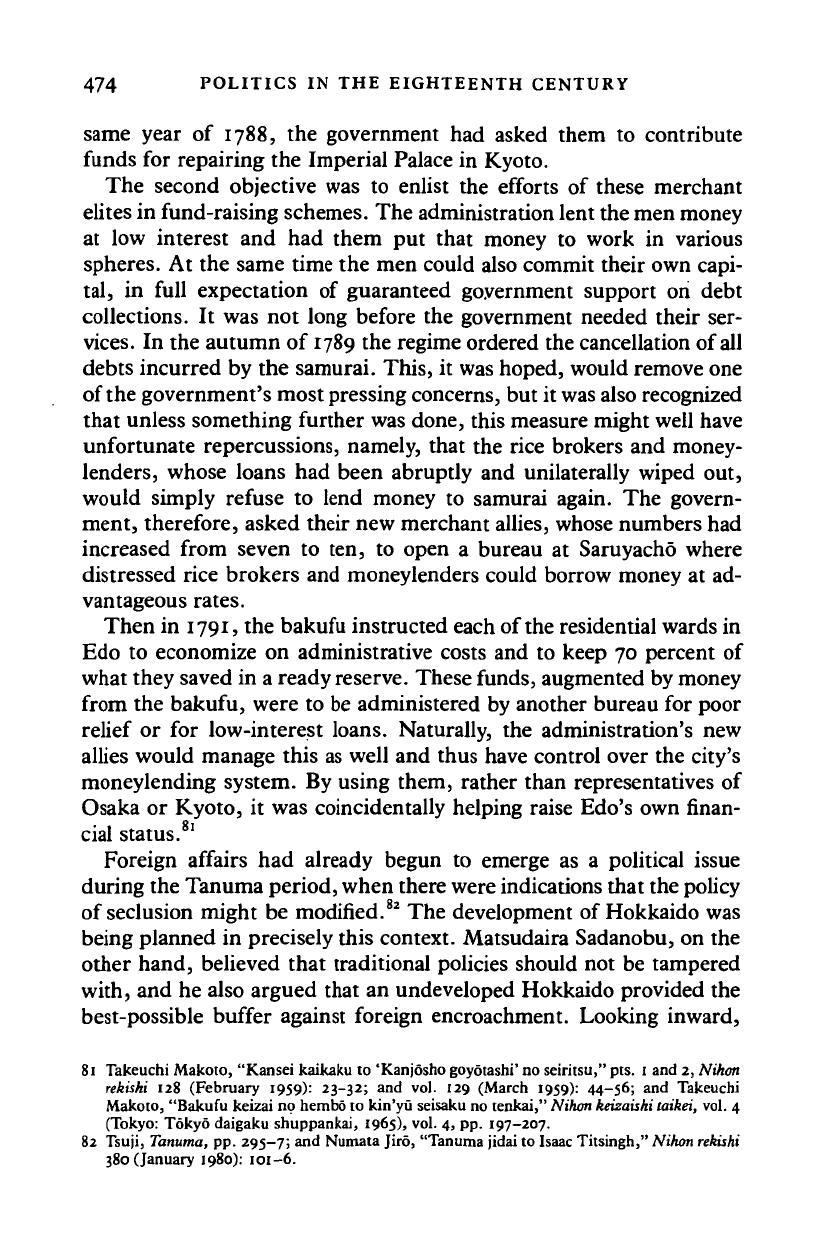
474 POLITICS IN THE EIGHTEENTH CENTURY
same year of 1788, the government had asked them to contribute
funds for repairing the Imperial Palace in Kyoto.
The second objective was to enlist the efforts of these merchant
elites in fund-raising schemes. The administration lent the men money
at low interest and had them put that money to work in various
spheres. At the same time the men could also commit their own capi-
tal,
in full expectation of guaranteed government support on debt
collections. It was not long before the government needed their ser-
vices.
In the autumn of 1789 the regime ordered the cancellation of all
debts incurred by the samurai. This, it was hoped, would remove one
of the government's most pressing concerns, but it was also recognized
that unless something further was done, this measure might well have
unfortunate repercussions, namely, that the rice brokers and money-
lenders, whose loans had been abruptly and unilaterally wiped out,
would simply refuse to lend money to samurai again. The govern-
ment, therefore, asked their new merchant allies, whose numbers had
increased from seven to ten, to open a bureau at Saruyacho where
distressed rice brokers and moneylenders could borrow money at ad-
vantageous rates.
Then in
1791,
the bakufu instructed each of
the
residential wards in
Edo to economize on administrative costs and to keep 70 percent of
what they saved in a ready
reserve.
These funds, augmented by money
from the bakufu, were to be administered by another bureau for poor
relief or for low-interest loans. Naturally, the administration's new
allies would manage this as well and thus have control over the city's
money lending system. By using them, rather than representatives of
Osaka or Kyoto, it was coincidentally helping raise Edo's own finan-
cial status.
81
Foreign affairs had already begun to emerge as a political issue
during the Tanuma period, when there were indications that the policy
of seclusion might be modified.
82
The development of Hokkaido was
being planned in precisely this context. Matsudaira Sadanobu, on the
other hand, believed that traditional policies should not be tampered
with, and he also argued that an undeveloped Hokkaido provided the
best-possible buffer against foreign encroachment. Looking inward,
81 Takeuchi Makoto, "Kansei kaikaku to 'Kanjosho goyotashi' no seiritsu," pts. I and 2, Nihon
rekishi 128 (February 1959): 23-32; and vol. 129 (March 1959): 44-56; and Takeuchi
Makoto, "Bakufu keizai no hembo to kin'yu seisaku no tenkai," Nihon keizaishi taikei, vol. 4
(Tokyo: Tokyo daigaku shuppankai, 1965), vol. 4, pp. 197-207.
82 Tsuji, Tanuma, pp. 295-7; and Numata Jiro, "Tanuma jidai to Isaac Titsingh," Nihon
rekishi
380 (January 1980): 101-6.
Cambridge Histories Online © Cambridge University Press, 2008
